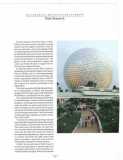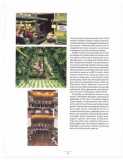In future bases on the Moon, Mars, or elsewhere in the solar system, naturally occuring ready-to-use life support resources — such as food, air, and water — will not be available. NASA is conducting research toward the development of modules that will recycle wastes produced by human and industrial processes and provide the essential ingredients for growing plants. The plants, in turn, will provide food, oxygen, and water and obviate the need to supply such resources from outside the bases.
At Kennedy Space Center (KSC), NASA is developing a Controlled Ecological Life Support System (CELSS). And in a novel government/commercial industry research partnership, The Land's agricultural research team at EPCOT Center is similarly testing new ways to sustain life in space as a research participant in the CELSS effort.
The Land, sponsored by Kraft General Foods, is an entertainment, research, and education facility at EPCOT Center, part of the Walt Disney World Resort, Lake Buena Vista, Fla. (right).
The cooperative KSC/Walt Disney World effort is simultaneously a research and development program, a technology demonstration that provides the public an unsual opportunity to see high technology at work, and an area of potential spinoff; the CELSS work may generate Earth use technology beneficial to the hydroponic (soilless growing) vegetable production industries of the world.
The project involves plant-growing racks and associated KSC-supplied bioregenerative equipment installed in a greenhouse near the end of The Land's boat ride (top right), on which visitors travel through five greenhouses displaying more than 30 crops from around the world. In the experimental greenhouse, plants are grown on A-frame structures (far right center) that make it possible to spray the roots from the inside with a hydroponic nutrient solution.
At KSC, the current focus of CELSS research involves growing plants in special trays in an atmospherically sealed, environmentally controlled chamber (far right). Wheat and soybeans have been grown hydroponically in the CELSS module; scientists monitor a number of environmental parameters, including gases produced in the process. Additional plant species will be integrated into future research, as will waste management and food processing modules.
At EPCOT Center, The Land researchers “have the latitude to try their ideas and conduct various studies on their own to maximize the scientific data return,” according to Dr. William Knott, KSC CELSS project scientist. The Land researchers are in an early stage. In their environmentally controlled greenhouse, they are growing plants hydroponically in six plant-growing racks, about one-third as many as in KSC's facility. Initial research involved the testing of software and hardware subsystems controlling the plant growing racks, which were developed under the joint research partnership between NASA and Walt Disney World. Additional research will study how microbial contaminants, such as fungi and bacteria, affect plant growth; such information is critical to developing a reliable CELSS.
“Eventually we will take the research a step further,” said Andrew Schuerger, research plant pathologist at The Land, “by testing biological control agents to determine how they will be able to prevent root disease and enhance plant growth.” Researchers are testing more than two dozen plant species, although 95 percent of commercial hydroponic vegetables grown are lettuce and cucumbers, The Land group will also investigate wheat, mung bean, winged bean, peppers, spinach, oats, barley, strawberries, herbs and other crops. Attention will focus on finding plants that can be grown together in a hydroponic environment without interfering with each other's growth patterns.

